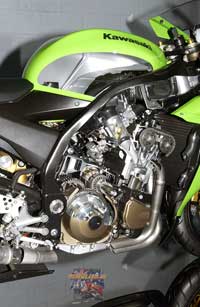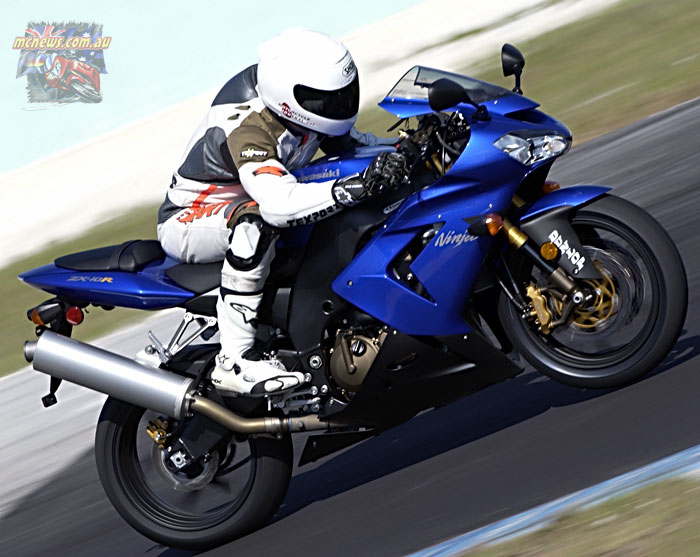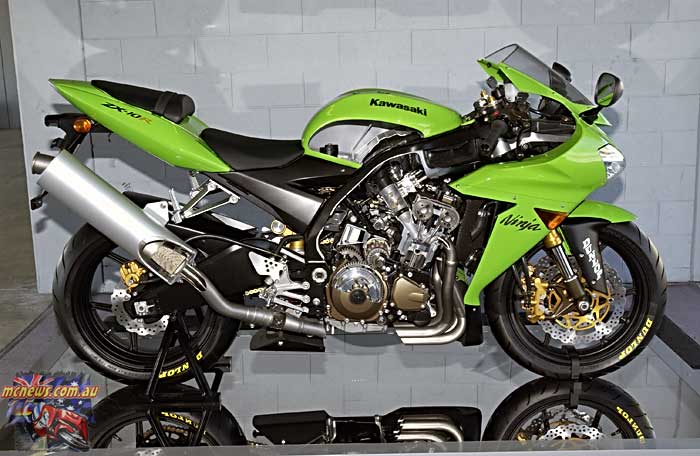Gen 1 ZX-10R Widowmaker
Watching the rain fall over the Homestead-Miami Speedway on day two of the Kawasaki ZX-10 press launch, a thousand thoughts are roaming around the great abyss between my ears.
Thoughts from the formative years of my spotty youth, when flared trousers, twin shocks and naked bikes were 20 years away from becoming retro; a time when the ultimate motorcycle was about to be released, the Ninja 900. Word on the street talked of wicked acceleration and 150mph top speeds, with braking and handling to match. Reliable, affordable and oozing sex appeal from every sculptured body panel, how could it get any better? Twenty years later, after a day in the hot seat of the 2004 Kawasaki ZX-10, all I can say is: “How can it get any better.”?
With no end to the rain in sight, the day was called and it was time to start heading for home. Kawasaki had given us ample track time the previous day and I for one was not unhappy. A recent high-speed get-off had made the thought of the new ZX-10 as the proverbial horse I needed to remount a little daunting. In preparation I decided; no heroics, just a steady ride so I could return in one piece to report my findings. Three sessions into my day, hard on the phenomenal anchors from over 150mph, I am happy to report I was doing just that.
The day had started out even slower than imagined in my worst nightmares. I just couldn’t bring myself to push the bike into the corners, so I concentrated on learning the track and getting familiar with the diminutive Kawasaki. At 170kg dry and rolling on a 1,385mm wheelbase, a very light touch was needed on the bars to negotiate Homestead’s tight infield turns.
With 184 ram-air assisted horsepower available at the crank, the same treatment was necessary with the throttle. Learning a new track and a new bike always takes a little time, so it took till my third session to start getting things figured out. To avoid any unnecessary inputs to the throttle or the bars in the turns, I hooked my outside leg up under the lip in the gas tank and used my lower body to control the bike. This was the confidence booster I was looking for, as my initial laps were spent feeling very ham-fisted with the throttle. With the huge amount of power available, each fraction of a turn puts out a lot of horses, and hard over in a turn is not the place to accidentally feed in any unwanted throttle.
I was already exploring the new engine’s power by now, and having only one problem: The ZX-10 makes the 2.2-mile (3.54km) circuit seem like a go-kart track. The bike is just so unbelievably fast it simply annihilates the straights. No sooner had I lined myself up out of the corners to release the trigger than it was time to get on the brakes. Even more incredible when you consider I was coming out of first gear corners in second to avoid any wheel spin or wheelies. Making solid, useable power down as low as four thousand rpms, big Z’s engine just keeps on pulling, getting progressively more powerful until it hits redline at 13,000rpm. The shift light comes on a little earlier, but with the bike capable of 90mph (145kph) in first gear, there were few opportunities to closely study the rev counter to see exactly where.


As with the first Ninja 900, the ZX-10 uses an inline, water-cooled four-cylinder engine, but here the similarities end. The new engine is fuel-injected, computer controlled, and uses a tri-axis transmission/crankshaft layout. This is to optimize space and keep the motor as small as possible to fit between the ultra narrow frame rails.
During the press briefing, we watched a video of the aluminium frames being made by a mixture of hi-tech robotics and human hands; it is one beefy looking bit of kit.
Out on display, a cutaway model on a mirrored stand allowed views into the engine and body parts. Looking into the head, the titanium exhaust valve wouldn’t be out of place as an object d’art. Each of the eight valves is 25.5mm in diameter while the intakes are 31mm. The intake ports are liquid-smooth and 43 mm throttle bodies feed fuel into the cylinders. These have dual throttle valves and fine atomizing injectors, technology borrowed from the automotive world. Air is provided in large doses from the huge ram-air intake that sits above the twin headlights. Passing through the frame tubes into the cavernous air box, it is good for an extra nine horsepower.
Flat-top pistons maximize combustion chamber efficiency while putting the squeeze on the mix; iridium spark plugs provide the fire. Compression ratio is a healthy 12.7:1, and plated cylinders keep the heat down while the pistons get their workout. On the other side of the cylinders, butterfly valves are used in the titanium exhaust pipes to keep the power smooth through the rev range.
The crankshaft is very light and compact, with its position in the featherweight cases helping keep the ZX-10’s centre of gravity as low as possible. Taking the power to the rear wheel is a six-speed close-ratio box and an adjustable slipper clutch. I have to confess I never downshifted hard enough to test it, but my bacon has been saved on another occasion from a similar system, so it is definitely a good thing.
The gearbox was the only real area of complaint from this corner. I repeatedly missed the third to fourth shift on the front straight and, by the end of the day, my big toe had lost a bunch of skin.
This aggravating problem resulted in a beautiful four cylinder howl would be heard reverberating off the straightaway’s front wall through first, second and third, followed by a loud stuttering, coughing sound as the bike slammed against the rev limiter staying stuck in third.
I also had some difficulty trying to short-shift out of turn seven, and had to ensure more of my boot was under the lever to eliminate the problem. Not being the only one having trouble, cyber space was buzzing about the situation by the time I got home. Oh the end of the world was nigh, and numerous experts appeared over night without ever having to leave their keyboards.
So, to get the story straight, I put a call in to Kawasaki’s Mel Moore. Well aware of the situation, KHI (Kawasaki Heavy Industries) had already flown in parts after our first day. It seems the problem lay in the shift detent spring being too stiff. A softer spring was being installed as we spoke, and Mel had heard nothing further to the negative at the time of writing. I should take a moment to explain that we were riding what are called “pilot production” bikes. These are hand built from existing parts and, according to Mr. Moore, “some parts are going to change before the bikes get to the showrooms.”
Visually the bike appeals to my more conservative tastes, coming to America in black, blue or green. With no wild graphics on the aggressive looking fairing, it is almost a little understated, while flush fit LED taillights and an attractive inner fender help contribute to the bikes svelte appearance.
It also shares the same 698mm width as Kawasaki’s own ZX-6R, which truly makes it a “1,000cc motor in a 600cc package.” Sitting on the bike for the first time it feels nothing like a litre bike should, and out on the track flicking it through the corkscrew instantly confirms the feeling.
As small as big bore sport bikes have become, there is always a certain amount of muscle needed in the turns with the extra weight, not so the ZX-10. Part of this was due to the tyres and suspension modifications.
For our test the bikes came shod with Dunlop 208 GP compounds as opposed to the purpose-built D218ZRs that will be on the production bikes. Sizes are 190/70ZR 17 for the rear and 120/70 ZR 17 for the front. Their triangulated profile, and the fact that the forks had been raised 5mm in the triple trees, aided the bikes short wheel base and ultra light weight as I came effortless off my knee out of turn four into turn five.
With three main straights at Homestead of close to equal length, the Kawasaki was regularly topping 150mph (240kph) pinned in fourth. giving ample opportunity to put the brakes to the test. Lap after lap, I would get faster and deeper into the turns, and lap after lap I was rewarded with effortless, fade-free braking. I think the four-piston, four-pad radial brake set up is the best I have ever used. Biting down on two trendy-looking 300mm petal style rotors, I have to say they are sensitive, but once my brain was dialled in to how much pressure to use, they were as good as it gets. The five-way lever gave me a bit of bother and only on position five was the lever close enough to the bar for me.
Allowing the brakes to work to their full potential is a set of 43mm inverted forks. Adjustable for the big three, the compression damping was set to seven clicks of 16, with rebound damping at 6 clicks out. Spring pre-load was set at 5mm and other than the rebound being slowed a little from nine clicks, these are the settings with which the bikes will be delivered.
The inner fork legs are coated with Diamond-Like Carbon (DLC) to reduce stiction and will be more resistant to road debris during normal riding.
The big test was braking for the first-gear turn eight. Turn seven is a long, fast right-hander that has the bike entering the straight at the top end of second or around mid range in third, depending how brave you are feeling. Shutting down at the top end of fourth, it was time to lose more than 100mph (160kph) quick. The back wheel would go a little light and the bike would weave slightly left to right, but I felt no need to add any more pre-load.
Coming out of turn eight, I used second gear to avoid wheel spin. Here, getting on the throttle hard, the bike got a little unsettled crossing onto the Nascar banking. It also gave some head shake making the shift from second to third and again going into fourth at maximum rpms; a steering damper might be a good investment if you are going to be doing a lot of track days.
Out back, the rear shock gave me no problems, doing everything it was supposed to with no squat under hard acceleration. As with the forks, we were running close to showroom settings. In addition to the usual adjustments, the rear ride height is adjustable by removal and addition of shims. It also has a top out spring, as does the front fork, and is attached to the swingarm by a lightweight aluminium linkage.
The swing arm itself is heavily braced and extra long as is the norm these days. Built to be highly rigid, it looks more than capable of dealing with the extra power these bikes are going to be making in race trim.
As the end of the first day drew to a close, I sat out my last session. Not back to full fitness yet; I was feeling good to have gotten through the day without incident. The bike was remarkably well behaved for such a fire-breathing monster and, with a restrained throttle hand, surprisingly easy to ride. A word of warning to the unwary: This bike is not going to tolerate fools easily, so please make sure your riding abilities are really what you think they are.
Chatting a couple of days later with ex-AMA Superbike Champion Jamie James about the bike, he let out a long, low whistle when I gave him the stats. Just think; when he was battling the world’s top riders in the early nineties, full-blown factory Superbikes weren’t making numbers anywhere close to this baby. All you have to do is head down to you local dealer, plop down the money and have a machine Jamie could only dream about ten years ago. “How can it get any better.”?
























